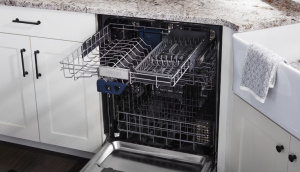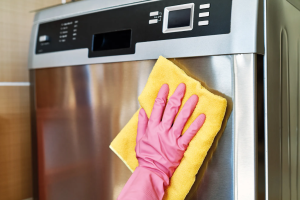How to Clean Your Dishwasher, A Comprehensive Guide
Maintaining a clean dishwasher is essential for ensuring optimal performance, prolonging the appliance’s lifespan, and guaranteeing hygienic dish cleaning. This comprehensive guide will walk you through the process of thoroughly cleaning your dishwasher, addressing common issues, and providing tips for regular maintenance. By following these steps, you’ll be able to keep your dishwasher running efficiently and effectively, whether you have a basic model or the best KitchenAid dishwasher on the market.
In this article, we’ll cover the importance of regular cleaning, signs that indicate your dishwasher needs attention, necessary tools and materials, a step-by-step cleaning guide, maintenance tips, and solutions to common dishwasher problems. By the end, you’ll have all the knowledge needed to keep your dishwasher in top condition.
Understanding the Cleaning Process
Why Clean Your Dishwasher?

Dishwashers require regular cleaning to prevent the accumulation of food particles, grease, and soap scum. These buildups can lead to several issues:
- Reduced cleaning efficiency
- Unpleasant odors
- Potential growth of bacteria and mold
- Shortened lifespan of the appliance
Regular cleaning ensures that your dishwasher operates at peak performance, effectively sanitizing your dishes and utensils while consuming less energy and water.
Signs Your Dishwasher Needs Cleaning
Several indicators suggest it’s time to clean your dishwasher:
- Unpleasant odors emanating from the appliance
- Visible residue or film on dishes after a wash cycle
- Reduced cleaning performance, with dishes coming out dirty or spotty
- Strange noises during operation
- Visible buildup of grime or mold inside the dishwasher
If you notice any of these signs, it’s crucial to clean your dishwasher promptly to prevent further issues and ensure optimal performance.
Tools and Materials Needed

Before beginning the cleaning process, gather the following items:
Here’s the table for tools and materials used for cleaning, along with their purposes:
| Tool/Material | Purpose |
|---|---|
| White vinegar | Natural cleaner and deodorizer |
| Baking soda | Deodorizer and mild abrasive |
| Dish soap | General cleaning |
| Soft brush or toothbrush | Scrubbing small areas |
| Microfiber cloth | Wiping surfaces |
| Toothpick or small brush | Detailing and unclogging spray arm holes |
Having these tools on hand will make the cleaning process more efficient and effective.
Step-by-Step Cleaning Guide
Cleaning the Exterior
Begin by cleaning the exterior of your dishwasher:
- Use a damp microfiber cloth and mild dish soap to wipe down the front panel, handle, and sides.
- Pay special attention to the control panel and door edges, where grime can accumulate.
- For stainless steel exteriors, use a specialized stainless steel cleaner to maintain the finish.
Cleaning the Interior
Removing and Cleaning the Racks and Utensil Holder
- Take out the racks and utensil holder.
- Scrub them with warm, soapy water and a soft brush to remove any stuck-on food particles or residue.
- Rinse thoroughly and set aside to dry.
Cleaning the Spray Arms
- Remove the spray arms if possible (consult your dishwasher’s manual for instructions).
- Check for any clogs in the spray arm holes.
- Use a toothpick or small brush to unclog any blocked holes.
- Rinse the spray arms under warm water to remove any loosened debris.
Cleaning the Filter
- Locate the filter at the bottom of the dishwasher.
- Remove the filter according to the manufacturer’s instructions.
- Rinse the filter under warm water to remove loose debris.
- Use a soft brush to scrub away any stubborn grime or buildup.
- Rinse thoroughly and replace the filter.
Deep Cleaning the Dishwasher

Using White Vinegar
- Place a dishwasher-safe container filled with 1 cup of white vinegar on the top rack.
- Run a hot water cycle without detergent to remove grease and grime.
Using Baking Soda
- After the vinegar cycle, sprinkle 1 cup of baking soda on the bottom of the dishwasher.
- Run a short hot water cycle to deodorize and remove stains.
Cleaning the Door Seals and Gaskets
- Wipe down the door seals and gaskets with a damp cloth to remove any buildup.
- Use a toothbrush to clean any tough spots or mold in the crevices.
Cleaning the Drain
- Check the dishwasher drain for any clogs or debris.
- Remove any visible obstructions to ensure water flows freely.
Maintaining a Clean Dishwasher
Regular Cleaning Schedule
To keep your dishwasher in top condition, follow this cleaning schedule:
Here’s the table outlining the frequency and tasks for cleaning and maintaining a dishwasher:
| Frequency | Task |
|---|---|
| After each use | Wipe down the interior and remove any visible food debris |
| Weekly | Clean the filter and check spray arms for clogs |
| Monthly | Perform a deep clean with vinegar and baking soda |
| Quarterly | Inspect and clean door seals, gaskets, and drain |
Tips for Daily Maintenance
- Scrape off excess food debris before loading dishes.
- Avoid overloading the dishwasher to ensure proper water circulation.
- Use the right amount of detergent as specified by the manufacturer.
- Run hot water in your sink before starting the dishwasher to ensure the cycle begins with hot water.
- Leave the dishwasher door slightly open after a cycle to allow moisture to evaporate.
Dealing with Common Dishwasher Issues

Persistent Odors
- Use lemon juice or vinegar regularly to combat odors.
- Check for hidden food debris in crevices or the filter.
- Run an empty cycle with a dishwasher cleaner designed to eliminate odors.
Cloudy Dishes or Glassware
- Ensure proper water temperature (120-140°F or 49-60°C).
- Use a rinse aid to prevent water spots and enhance drying.
- Check your water hardness and adjust detergent usage accordingly.
Poor Cleaning Performance
- Inspect spray arms and filter regularly for clogs or damage.
- Run a cleaning cycle more frequently if you have hard water.
- Consider using a water softener if your area has very hard water.
The best KitchenAid dishwashers often come with advanced features that can help maintain cleanliness and performance. For example, some models include self-cleaning filters and specialized cleaning cycles that can make maintenance easier. However, even the most advanced dishwashers require regular cleaning and care to function optimally.
Conclusion
Maintaining a clean dishwasher is crucial for ensuring efficient operation, prolonging the appliance’s lifespan, and guaranteeing hygienic dish cleaning. By following this comprehensive guide, you can keep your dishwasher in top condition, whether you have a basic model or the best KitchenAid dishwasher available. Regular cleaning and maintenance will not only improve your dishwasher’s performance but also save you money on energy bills and potential repairs in the long run.
Remember to:
- Clean the exterior and interior regularly
- Perform monthly deep cleans with vinegar and baking soda
- Maintain a regular cleaning schedule
- Address common issues promptly
By incorporating these practices into your routine, you’ll ensure that your dishwasher continues to provide sparkling clean dishes for years to come. If you’re interested in upgrading, researching the best KitchenAid dishwasher models can also help you choose an appliance that combines top performance with ease of maintenance.

Michael Thompson is a highly skilled appliance technician specializing in KitchenAid dishwashers. With many years of experience, Michael is renowned for his expertise in handling various models of KitchenAid dishwashers, ensuring optimal performance and longevity. His dedication to customer satisfaction and in-depth knowledge of appliance technology make him a trusted figure in his community. Michael’s commitment to quality service has earned him a reputation as one of the best in his field.








This article is helpful! Can you explain the process for removing and cleaning the dishwasher racks? What precautions should be taken to avoid damaging them?
Hi Michael,
I’m glad you found the article helpful! To remove and clean your dishwasher racks, follow these steps:
Remove the Racks: Start by pulling out the lower rack completely. You might need to lift the front slightly to get it out of the tracks. For the upper rack, there are usually release levers or tabs on either side that you need to press to lift it out.
Clean the Racks: Use a damp cloth or sponge to wipe down the racks. If there’s stubborn residue, mix some mild dish soap with warm water and use a soft brush to scrub the affected areas. For any hard water deposits, a mixture of equal parts vinegar and water can be effective. Be sure to rinse thoroughly to remove any soap or vinegar residue.
Dry and Reinstall: Allow the racks to air dry completely before placing them back in the dishwasher. Once dry, slide them back into their tracks, making sure they are securely positioned.
Precautions:
Avoid using abrasive cleaners or scrubbers as they can damage the coating on the racks.
Ensure that the racks are completely dry before reinstalling to prevent any potential rusting.
I hope this helps! Let me know if you have any more questions.
Best regards,
Very informative guide! What are the best methods for cleaning the spray arms to ensure they are free from clogs? Are there any tools or techniques that make this easier?
Hi David,
Thank you for your kind words! To clean the spray arms and ensure they are free from clogs, you can follow these methods:
Remove and Inspect: First, remove the spray arms from the dishwasher according to your model’s instructions. Check for any visible debris or buildup.
Soak in Vinegar: Soak the spray arms in a solution of warm water and white vinegar for about 30 minutes. This helps to loosen any mineral deposits and grime.
Clean with a Toothbrush: Use a soft toothbrush or a small brush to gently scrub the spray arms, paying close attention to the nozzles and other small openings.
Use a Pin: For any stubborn clogs in the spray arm nozzles, you can use a straight pin or a needle to carefully dislodge any debris.
Rinse Thoroughly: Rinse the spray arms under running water to ensure all vinegar and debris are washed away before reattaching them.
Check for Proper Functioning: Once reattached, run a short cycle with no dishes inside to ensure the spray arms are functioning correctly and distributing water evenly.
There are also specialized brushes and tools available specifically for cleaning dishwasher spray arms, which can make the process more convenient. You can find these at most home improvement or kitchenware stores.
I hope this helps! Let me know if you have any other questions.
Best,
Interesting read! How do you deal with unpleasant odors coming from the dishwasher? Are there particular cleaning solutions or methods that work best for eliminating these smells?
Hi Selena,
Thank you for your question! Unpleasant odors from the dishwasher can be quite bothersome. Here are some effective methods to tackle those smells:
Regular Cleaning: Ensure you clean the dishwasher’s filter and spray arms regularly. Food particles and grease can accumulate and cause odors.
Vinegar and Baking Soda: Place a cup of white vinegar on the top rack and run a hot water cycle. After that, sprinkle a cup of baking soda on the bottom of the dishwasher and run another hot water cycle. These natural ingredients help to neutralize odors and clean the interior.
Lemon: For a fresh scent, you can also place lemon slices or lemon juice on the top rack and run a hot cycle. This not only helps with odors but also leaves a pleasant fragrance.
Check the Drain: Make sure that the drain at the bottom of the dishwasher is not clogged. Sometimes, debris can cause unpleasant smells.
Odor Eliminator: There are dishwasher cleaning products specifically designed to eliminate odors. Look for products with enzymes or antibacterial properties.
Following these tips should help in keeping your dishwasher smelling fresh!
Best regards,
Great guide! What are the best practices for cleaning the dishwasher’s interior and drain? Are there any steps that should be taken to prevent future build-up?
Hi Major_Barrios,
Thank you for your feedback! For cleaning your dishwasher’s interior and drain, here are some best practices:
Interior Cleaning: Regularly wipe down the interior with a mixture of vinegar and water or a mild detergent. Pay special attention to the spray arms and any areas where food particles may accumulate.
Drain Cleaning: Remove and clean the filter and drain screen according to the manufacturer’s instructions. Check for any debris that might obstruct the drain and remove it.
Preventing Build-Up: To prevent future build-up, run a cleaning cycle with a dishwasher cleaner or a cup of white vinegar placed on the top rack. Ensure you rinse dishes before loading them to reduce food residue. Additionally, periodically inspect and clean the drain and filter to avoid clogs.
By following these steps, you can maintain your dishwasher’s performance and prolong its lifespan.
Feel free to reach out if you have more questions!
Thanks for the insights! How do you properly clean the dishwasher’s filter if it’s been neglected for a long time? Are there any specific steps or products to use?
Dear Sophia!
To clean a neglected dishwasher filter, follow these steps:
Remove the Filter: Check your manual for instructions and take out the filter from the bottom of the dishwasher.
Soak in Warm, Soapy Water: Use warm water and dish soap to soak the filter for 10-15 minutes.
Scrub Away Debris: Gently scrub the filter with a soft brush or toothbrush.
Rinse and Reinstall: Rinse thoroughly and put it back.
You can use a mixture of vinegar and baking soda for a deeper clean.
Thank you.
Very useful information! Can you provide tips for maintaining a clean dishwasher on a regular basis? How often should the different components be cleaned to ensure optimal performance?
Hi Liam!
To maintain a clean dishwasher, here are some tips:
Clean the filter: Every 1-2 months to prevent buildup of food debris.
Wipe down the seals and door: Weekly, to avoid mold and grime.
Run a cleaning cycle: Monthly, using a dishwasher cleaner or vinegar to remove grease and odors.
Check the spray arms: Every few months to ensure no clogs.
Inspect the drain: Regularly, to ensure proper water flow.
Regular care ensures optimal performance and longevity!
Thank.